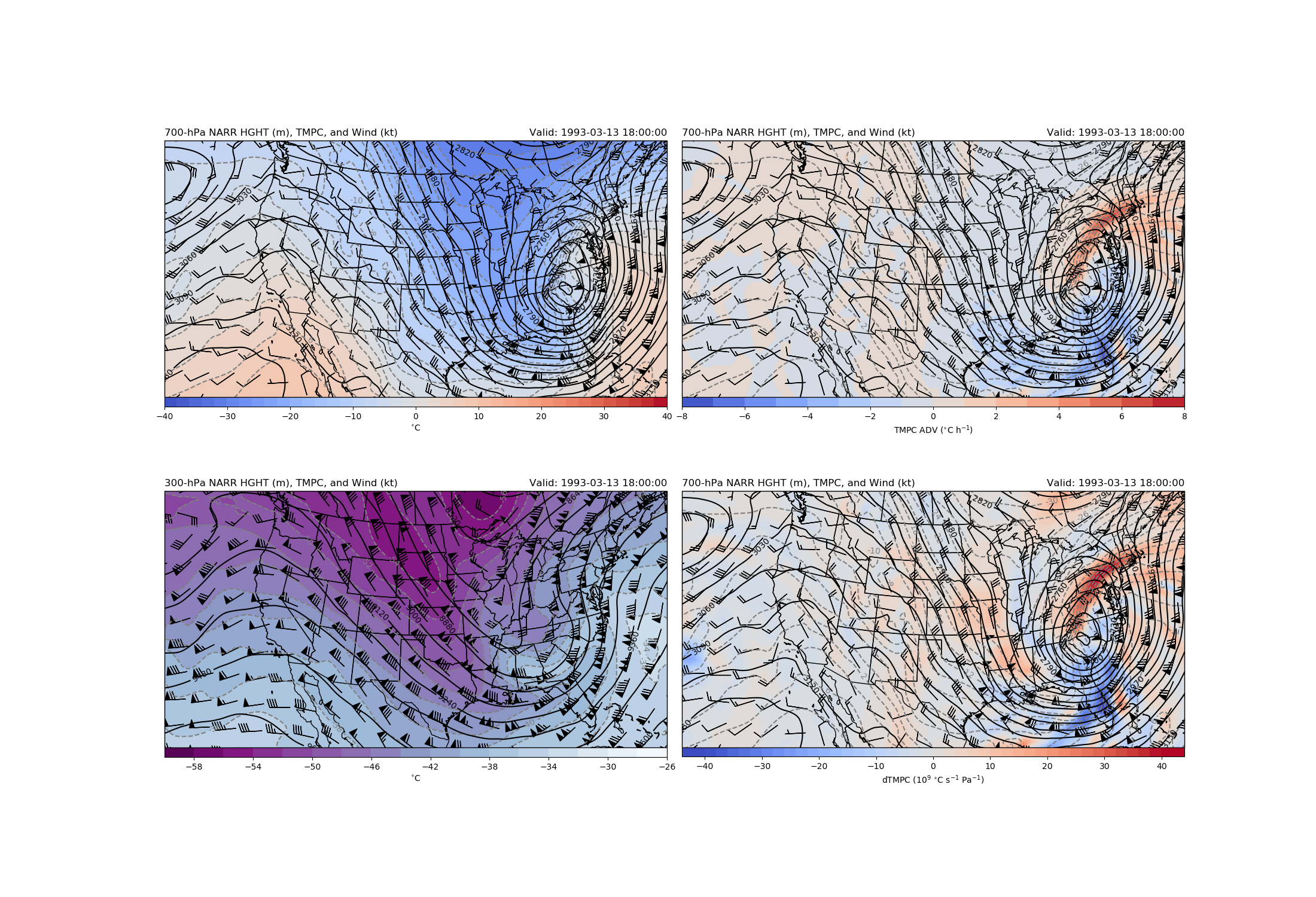Note
Click here to download the full example code
Differential Temperature Advection with NARR Data¶
By: Kevin Goebbert
This example creates a four-panel plot to illustrate the difference between single level temperature advection and a computed differential temperature advection between two layers. This example makes use of NARR output.
import cartopy.crs as ccrs
import cartopy.feature as cfeature
import matplotlib.gridspec as gridspec
import matplotlib.pyplot as plt
import metpy.calc as mpcalc
from metpy.units import units
import numpy as np
import xarray as xr
Data Input¶
Use Xarray to access GFS data from THREDDS resource and uses metpy accessor to parse file to make it easy to pull data using common coordinate names (e.g., vertical) and attach units.
ds = xr.open_dataset('https://thredds.ucar.edu/thredds/dodsC/'
'casestudies/python-gallery/NARR_19930313_1800.nc').metpy.parse_cf()
# Get lat/lon data from file
lats = ds.lat.data
lons = ds.lon.data
# Calculate variable dx, dy values for use in calculations
dx, dy = mpcalc.lat_lon_grid_deltas(lons, lats)
# Get 700-hPa data and smooth
level = 700 * units.hPa
hght_700 = mpcalc.smooth_n_point(ds['Geopotential_height_isobaric'].metpy.sel(
vertical=level).squeeze(), 9)
tmpk_700 = mpcalc.smooth_n_point(ds['Temperature_isobaric'].metpy.sel(
vertical=level).squeeze(), 9)
uwnd_700 = mpcalc.smooth_n_point(
ds['u-component_of_wind_isobaric'].metpy.sel(vertical=level).squeeze(), 9)
vwnd_700 = mpcalc.smooth_n_point(
ds['v-component_of_wind_isobaric'].metpy.sel(vertical=level).squeeze(), 9)
# Get 300-hPa data and
level = 300 * units.hPa
hght_300 = mpcalc.smooth_n_point(ds['Geopotential_height_isobaric'].metpy.sel(
vertical=level).squeeze(), 9)
tmpk_300 = mpcalc.smooth_n_point(ds['Temperature_isobaric'].metpy.sel(
vertical=level).squeeze(), 9)
uwnd_300 = mpcalc.smooth_n_point(
ds['u-component_of_wind_isobaric'].metpy.sel(vertical=level).squeeze(), 9)
vwnd_300 = mpcalc.smooth_n_point(
ds['v-component_of_wind_isobaric'].metpy.sel(vertical=level).squeeze(), 9)
# Convert Temperatures to degC
tmpc_700 = tmpk_700.to('degC')
tmpc_300 = tmpk_300.to('degC')
# Get time in a nice datetime object format
vtime = ds.time.values.astype('datetime64[ms]').astype('O')[0]
Differential Temperature Advection Calculation¶
Use MetPy advection funtion to calculate temperature advection at 700 and 300 hPa, then manually compute the differential between those two layers. The differential temperature advection is then valid at 500 hPa (due to centered differencing) and is the same level that height changes due to absolute vorticity advection is commonly assessed.
# Use MetPy advection function to calculate temperature advection at two levels
tadv_700 = mpcalc.advection(tmpk_700, (uwnd_700, vwnd_700),
(dx, dy), dim_order='yx').to_base_units()
tadv_300 = mpcalc.advection(tmpk_300, (uwnd_300, vwnd_300),
(dx, dy), dim_order='yx').to_base_units()
# Centered finite difference to calculate differential temperature advection
diff_tadv = ((tadv_700 - tadv_300)/(400 * units.hPa)).to_base_units()
Make Four Panel Plot¶
A four panel plot is produced to illustrate the temperature fields at two levels (700 and 300 hPa), which are common fields to be plotted. Then a panel containing the evaluated temperature advection at 700 hPa and differential temperature advection between 700 and 300 hPa. Of meteorological significance is the difference between these two advection plots. For the QG Height Tendency equation, the forcing term is proportional to the differential temperature advection, which paints a slightly different picture than just the 700-hPa temperature advection alone.
To create the four panel plot it takes a bit of code at this point. The following code is segmented into Upper-left, Lower-left, Upper-right, Lower-right panels using matplotlib’s gridspec to help with spacing.
# Set up plot crs (mapcrs) and the data crs, will need to transform all variables
mapcrs = ccrs.LambertConformal(central_longitude=-100, central_latitude=35,
standard_parallels=(30, 60))
datacrs = ccrs.PlateCarree()
# Set some common contour interval levels
clevs_700_tmpc = np.arange(-40, 41, 2)
clevs_700_hght = np.arange(0, 8000, 30)
clevs_300_hght = np.arange(0, 10000, 120)
# Create slice to reduce number of wind barbs at plot time
wind_slice = (slice(None, None, 10), slice(None, None, 10))
# Start figure
fig = plt.figure(1, figsize=(22, 15))
# Use gridspec to help size elements of plot; small top plot and big bottom plot
gs = gridspec.GridSpec(nrows=2, ncols=2, height_ratios=[1, 1], hspace=0.03, wspace=0.03)
# Upper-left panel (700-hPa TMPC)
ax1 = plt.subplot(gs[0, 0], projection=mapcrs)
ax1.set_extent([-130, -72, 25, 49], ccrs.PlateCarree())
ax1.add_feature(cfeature.COASTLINE.with_scale('50m'))
ax1.add_feature(cfeature.STATES.with_scale('50m'))
cf = ax1.contourf(lons, lats, tmpc_700, clevs_700_tmpc,
cmap=plt.cm.coolwarm, transform=datacrs)
cb = plt.colorbar(cf, orientation='horizontal', pad=0, aspect=50)
cb.set_label(r'$^{\circ}$C')
csf = ax1.contour(lons, lats, tmpc_700, clevs_700_tmpc, colors='grey',
linestyles='dashed', transform=datacrs)
plt.clabel(csf, fmt='%d')
cs = ax1.contour(lons, lats, hght_700, clevs_700_hght, colors='black', transform=datacrs)
plt.clabel(cs, fmt='%d')
ax1.barbs(lons[wind_slice], lats[wind_slice],
uwnd_700.to('kt')[wind_slice].m, vwnd_700[wind_slice].to('kt').m,
pivot='middle', color='black', transform=datacrs)
plt.title('700-hPa NARR HGHT (m), TMPC, and Wind (kt)', loc='left')
plt.title('Valid: {}'.format(vtime), loc='right')
# Lower-left panel (300-hPa TMPC)
ax2 = plt.subplot(gs[1, 0], projection=mapcrs)
ax2.set_extent([-130, -72, 25, 49], ccrs.PlateCarree())
ax2.add_feature(cfeature.COASTLINE.with_scale('50m'))
ax2.add_feature(cfeature.STATES.with_scale('50m'))
cf = ax2.contourf(lons, lats, tmpc_300, range(-60, -24, 2),
cmap=plt.cm.BuPu_r, transform=datacrs)
cb = plt.colorbar(cf, orientation='horizontal', pad=0, aspect=50)
cb.set_label(r'$^{\circ}$C')
csf = ax2.contour(lons, lats, tmpc_300, range(-60, 0, 2),
colors='grey', linestyles='dashed', transform=datacrs)
plt.clabel(csf, fmt='%d')
cs = ax2.contour(lons, lats, hght_300, clevs_300_hght, colors='black', transform=datacrs)
plt.clabel(cs, fmt='%d')
ax2.barbs(lons[wind_slice], lats[wind_slice],
uwnd_300.to('kt')[wind_slice].m, vwnd_300[wind_slice].to('kt').m,
pivot='middle', color='black', transform=datacrs)
plt.title('300-hPa NARR HGHT (m), TMPC, and Wind (kt)', loc='left')
plt.title('Valid: {}'.format(vtime), loc='right')
# Upper-right panel (700-hPa TMPC Adv)
ax3 = plt.subplot(gs[0, 1], projection=mapcrs)
ax3.set_extent([-130, -72, 25, 49], ccrs.PlateCarree())
ax3.add_feature(cfeature.COASTLINE.with_scale('50m'))
ax3.add_feature(cfeature.STATES.with_scale('50m'))
cf = ax3.contourf(lons, lats, tadv_700*3600, range(-8, 9, 1),
cmap=plt.cm.coolwarm, transform=datacrs)
cb = plt.colorbar(cf, orientation='horizontal', pad=0, aspect=50)
cb.set_label(r'TMPC ADV ($^{\circ}$C h$^{-1}$)')
csf = ax3.contour(lons, lats, tmpc_700, clevs_700_tmpc, colors='grey',
linestyles='dashed', transform=datacrs)
plt.clabel(csf, fmt='%d')
cs = ax3.contour(lons, lats, hght_700, clevs_700_hght, colors='black', transform=datacrs)
plt.clabel(cs, fmt='%d')
ax3.barbs(lons[wind_slice], lats[wind_slice],
uwnd_700.to('kt')[wind_slice].m, vwnd_700[wind_slice].to('kt').m,
pivot='middle', color='black', transform=datacrs)
plt.title('700-hPa NARR HGHT (m), TMPC, and Wind (kt)', loc='left')
plt.title('Valid: {}'.format(vtime), loc='right')
# Lower-right panel (diff TMPC)
ax4 = plt.subplot(gs[1, 1], projection=mapcrs)
ax4.set_extent([-130, -72, 25, 49], ccrs.PlateCarree())
ax4.add_feature(cfeature.COASTLINE.with_scale('50m'))
ax4.add_feature(cfeature.STATES.with_scale('50m'))
cf = ax4.contourf(lons, lats, diff_tadv*1e9, clevs_700_tmpc,
cmap=plt.cm.coolwarm, extend='both', transform=datacrs)
cb = plt.colorbar(cf, orientation='horizontal', pad=0, aspect=50, extendrect=True)
cb.set_label(r'dTMPC ($10^9$ $^{\circ}$C s$^{-1}$ Pa$^{-1}$)')
csf = ax4.contour(lons, lats, tmpc_700, clevs_700_tmpc, colors='grey',
linestyles='dashed', transform=datacrs)
plt.clabel(csf, fmt='%d')
cs = ax4.contour(lons, lats, hght_700, clevs_700_hght, colors='black', transform=datacrs)
plt.clabel(cs, fmt='%d')
ax4.barbs(lons[wind_slice], lats[wind_slice],
uwnd_700.to('kt')[wind_slice].m, vwnd_700[wind_slice].to('kt').m,
pivot='middle', color='black', transform=datacrs)
plt.title('700-hPa NARR HGHT (m), TMPC, and Wind (kt)', loc='left')
plt.title('Valid: {}'.format(vtime), loc='right')
plt.show()

Total running time of the script: ( 0 minutes 5.712 seconds)